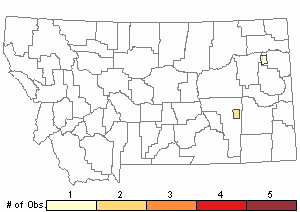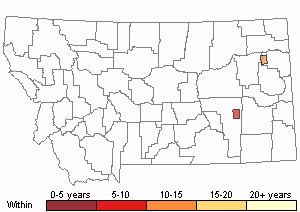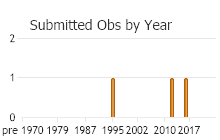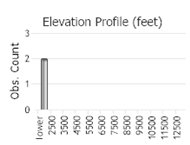View in other NatureServe Network Field Guides
NatureServe
Montana
Utah
Wyoming
Idaho
Wisconsin
British Columbia
South Carolina
Yukon
California
New York
Wandering Glider - Pantala flavescens
General Description
We do not yet have descriptive information on this species. Please try the buttons above to search for information from other sources.
Species Range
Range Comments
The Wandering Glider is distributed throughout most of the southern half of North America south to the tropics. They also commonly occur in the tropics of the eastern hemisphere as well as many oceanic islands and tropical regions. Interestingly, the only continent they are absent from is Europe (Dunkle 2000, Paulson 2009). In Montana, they have only been collected at Far West Pond, near Rosebud, Rosebud County (may be vagrants from farther south) (Miller and Gustafson 1996).
Observations in Montana Natural Heritage Program Database
Number of Observations: 3
(Click on the following maps and charts to see full sized version)
Map Help and Descriptions
Relative Density

Recency



 (Observations spanning multiple months or years are excluded from time charts)
(Observations spanning multiple months or years are excluded from time charts)
Migration
Wandering Gliders are highly migratory and posses impressive dispersal powers. They spend much of their time wandering long distances searching for recently filled rain pools where they breed. In North America, they are resident in the southern United States, but adults will often migrate north in the spring to breed. These young develop and emerge, eventually migrating south again in the fall (Dunkle 2000, Nikula et al. 2002, Paulson 2009).
Montana has only a single record of Wandering Glider and they may have been migrating vagrants from further south (Miller and Gustafson 1996).
Habitat
The habitat of the Wandering Glider includes a wide variety of temporary pools, ponds, puddles, other wetlands, as well as ditches, artificial wetlands, garden ponds and even swimming pools. Fishless environments are the usual (Dunkle 2000, Nikula et al. 2002, Paulson 2009).
National Vegetation Classification System Groups Associated with this Species
Forest and Woodland
Deciduous Forest and Woodland
Grassland
Lowland - Prairie Grassland
Sparse and Barren
Sparse and Barren
Wetland and Riparian
Alkaline - Saline Wetlands
Peatland
Riparian and Wetland Forest
Riparian Shrubland
Wet Meadow and Marsh
Food Habits
Larvae feed on a wide variety of aquatic insects, such as mosquito larvae, other aquatic fly larvae, mayfly larvae, and freshwater shrimp. They will also eat very small fish and tadpoles.
Adult- The dragonfly will eat almost any soft-bodied flying insect including mosquitoes, flies, small moths, mayflies, and flying ants or termites.
Reproductive Characteristics
Male Wandering Gliders patrol lengthy territories with rapid back and forth flights over the water. Pairs meet at breeding sites, copulation is brief and oviposition is initiated in tandem by straight flights where the female taps the water at regular intervals; oviposition is also completed by single females (Dunkle 2000, Paulson 2009).
Stewardship Responsibility
References
- Literature Cited AboveLegend:
 View Online Publication
View Online Publication Dunkle, S.W. 2000. Dragonflies through binoculars: A field guide to dragonflies of North America. New York, NY. Oxford University Press. 266 pp.
Dunkle, S.W. 2000. Dragonflies through binoculars: A field guide to dragonflies of North America. New York, NY. Oxford University Press. 266 pp. Miller, K.B. and D.L. Gustafson. 1996. Distribution records of the Odonata of Montana. Bulletin of American Odonatology 3(4):75-88.
Miller, K.B. and D.L. Gustafson. 1996. Distribution records of the Odonata of Montana. Bulletin of American Odonatology 3(4):75-88. Nikula, B., J. Sones, D.W. Stokes, and L.Q. Stokes. 2002. Stokes beginner's guide to dragonflies and damselflies. Boston: Little, Brown. 159 pp.
Nikula, B., J. Sones, D.W. Stokes, and L.Q. Stokes. 2002. Stokes beginner's guide to dragonflies and damselflies. Boston: Little, Brown. 159 pp. Paulson, D.R. 2009. Dragonflies and Damselflies of the West. Princeton University Press, Princeton. 535 pp.
Paulson, D.R. 2009. Dragonflies and Damselflies of the West. Princeton University Press, Princeton. 535 pp.
- Web Search Engines for Articles on "Wandering Glider"
- Additional Sources of Information Related to "Insects"





